AMD A10-7800 Review: Testing the A10 65W Kaveri
by Ian Cutress on July 31, 2014 8:00 AM ESTCPU Benchmarks
The dynamics of CPU Turbo modes, both Intel and AMD, can cause concern during environments with a variable threaded workload. There is also an added issue of the motherboard remaining consistent, depending on how the motherboard manufacturer wants to add in their own boosting technologies over the ones that Intel would prefer they used. In order to remain consistent, we implement an OS-level unique high performance mode on all the CPUs we test which should override any motherboard manufacturer performance mode.
HandBrake v0.9.9: link
For HandBrake, we take two videos (a 2h20 640x266 DVD rip and a 10min double UHD 3840x4320 animation short) and convert them to x264 format in an MP4 container. Results are given in terms of the frames per second processed, and HandBrake uses as many threads as possible.
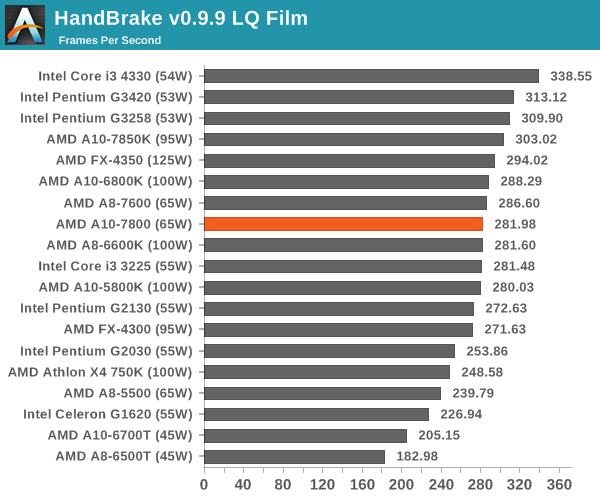
The latest Intel processors have the lead for low quality Handbrake conversion, and despite the generational gap between the FX-4350 and the A10-7800, the extra MHz is preferred here.

For large frame manipulation, the latest architectures mixed with the most threads perform best.
Agisoft Photoscan – 2D to 3D Image Manipulation: link
Agisoft Photoscan creates 3D models from 2D images, a process which is very computationally expensive. The algorithm is split into four distinct phases, and different phases of the model reconstruction require either fast memory, fast IPC, more cores, or even OpenCL compute devices to hand. Agisoft supplied us with a special version of the software to script the process, where we take 50 images of a stately home and convert it into a medium quality model. This benchmark typically takes around 15-20 minutes on a high end PC on the CPU alone, with GPUs reducing the time.
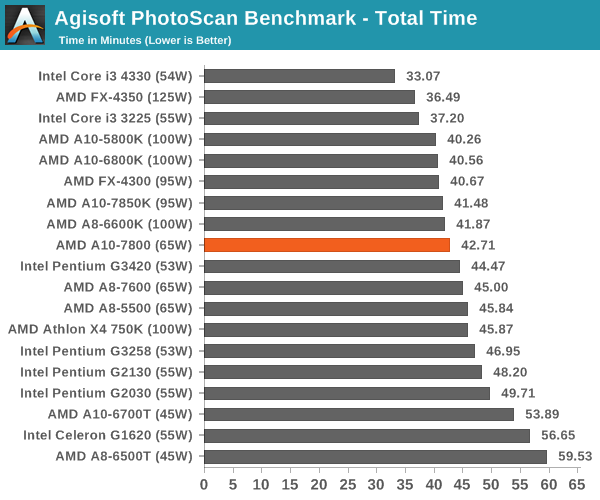
Dolphin Benchmark: link
Many emulators are often bound by single thread CPU performance, and general reports tended to suggest that Haswell provided a significant boost to emulator performance. This benchmark runs a Wii program that raytraces a complex 3D scene inside the Dolphin Wii emulator. Performance on this benchmark is a good proxy of the speed of Dolphin CPU emulation, which is an intensive single core task using most aspects of a CPU. Results are given in minutes, where the Wii itself scores 17.53 minutes.
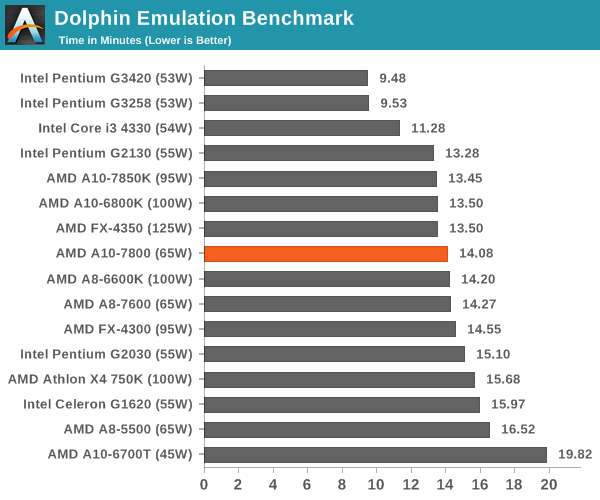
Dolphin seems to work best with high single core speed and Haswell.
WinRAR 5.0.1: link
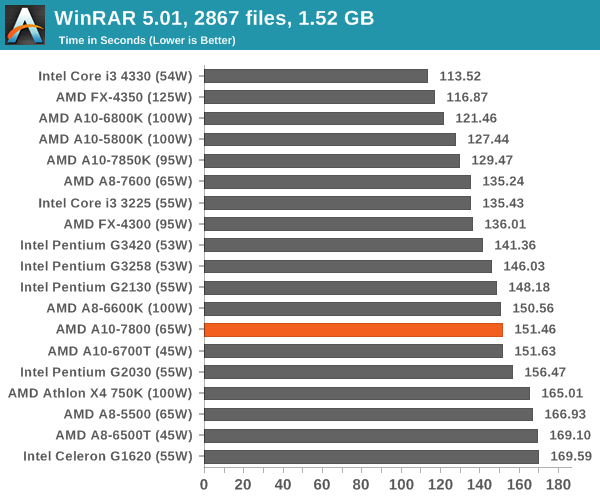
PCMark8 v2 OpenCL on IGP
A new addition to our CPU testing suite is PCMark8 v2, where we test the Work 2.0 and Creative 3.0 suites in OpenCL mode. As this test is new, we have not run it on many AMD systems yet and will do so as soon as we can.
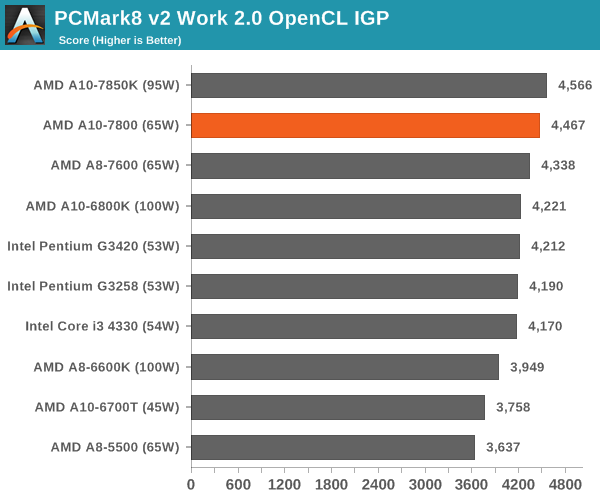
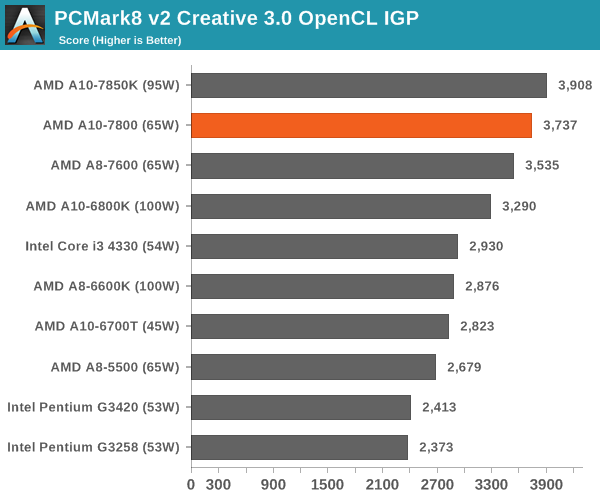
The combination of processor graphics and OpenCL support push the AMD APUs up to the top of our PCMark tests.
Hybrid x265
Hybrid is a new benchmark, where we take a 4K 1500 frame video and convert it into an x265 format without audio. Results are given in frames per second.
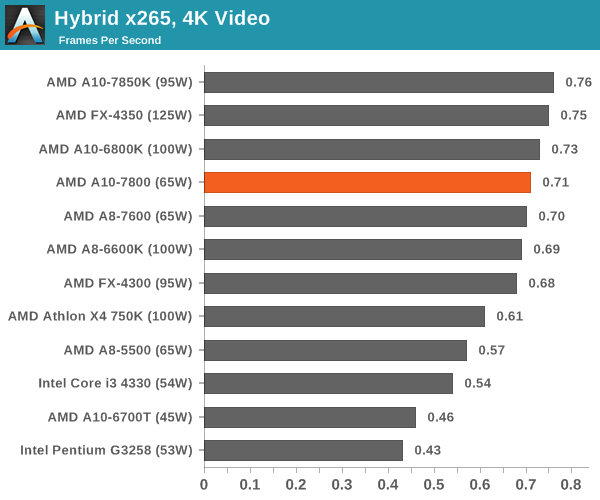
Cinebench R15


Cinebench is typically Intel territory for high IPC processors, but when it comes to multithreaded rendering, extra threads help.
3D Particle Movement
3DPM is a self-penned benchmark, taking basic 3D movement algorithms used in Brownian Motion simulations and testing them for speed. High floating point performance, MHz and IPC wins in the single thread version, whereas the multithread version has to handle the threads and loves more cores.
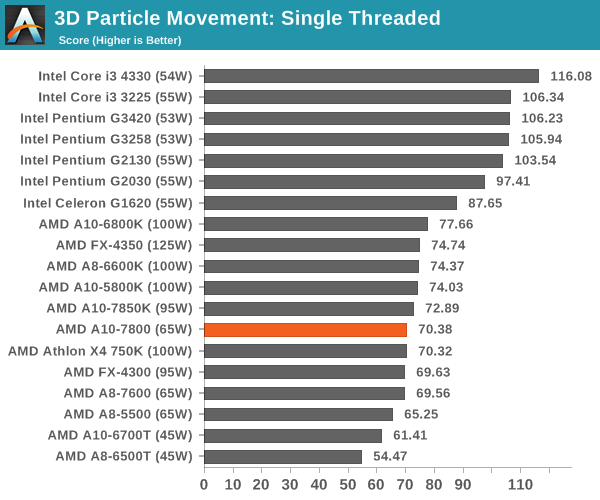
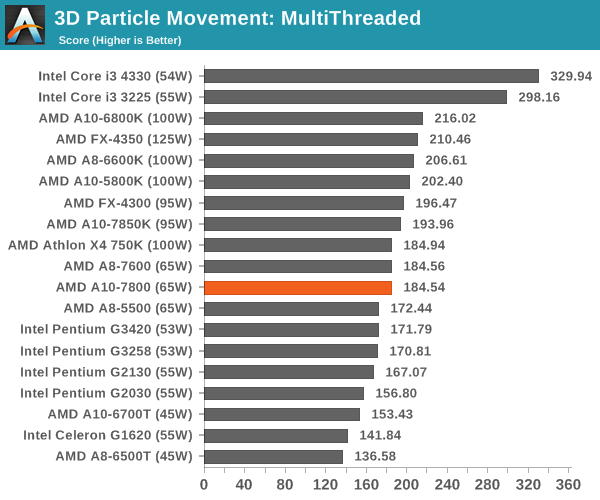
All the calculations in 3DPM deal with floating point numbers, a known sink for AMD compute.
FastStone Image Viewer 4.9
FastStone is the program I use to perform quick or bulk actions on images, such as resizing, adjusting for color and cropping. In our test we take a series of 170 images in various sizes and formats and convert them all into 640x480 .gif files, maintaining the aspect ratio. FastStone does not use multithreading for this test, and results are given in seconds.
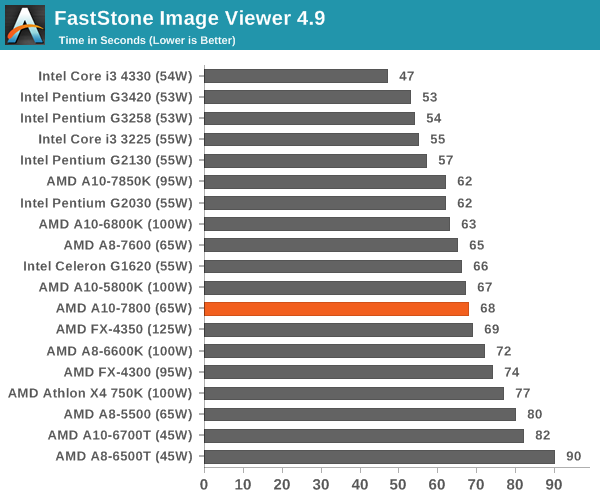
Web Benchmarks
On the lower end processors, general usability is a big factor of experience, especially as we move into the HTML5 era of web browsing. For our web benchmarks, we take four well known tests with Chrome 35 as a consistent browser.
Sunspider 1.0.2

Mozilla Kraken 1.1
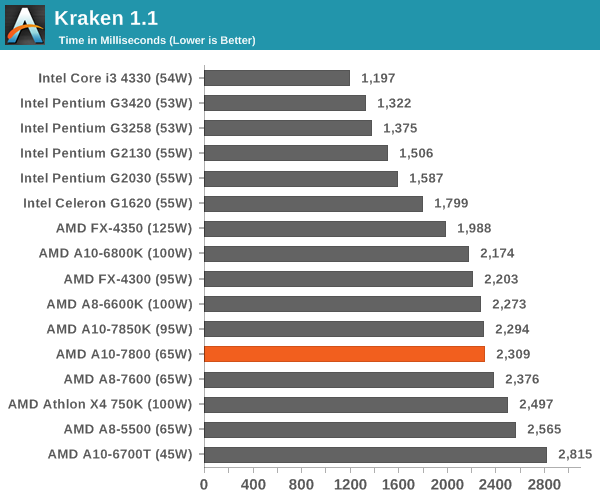
WebXPRT
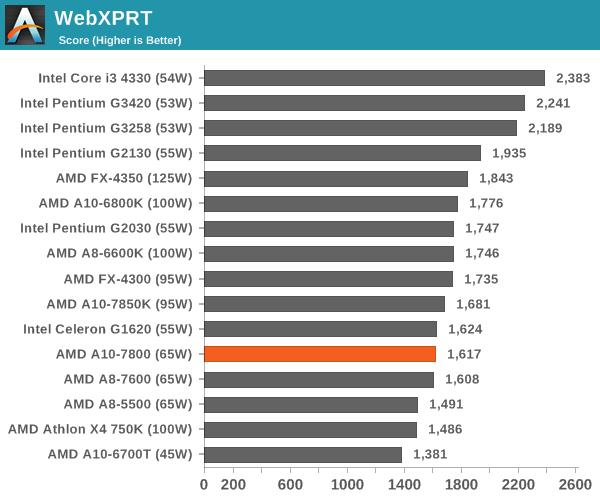
Google Octane v2
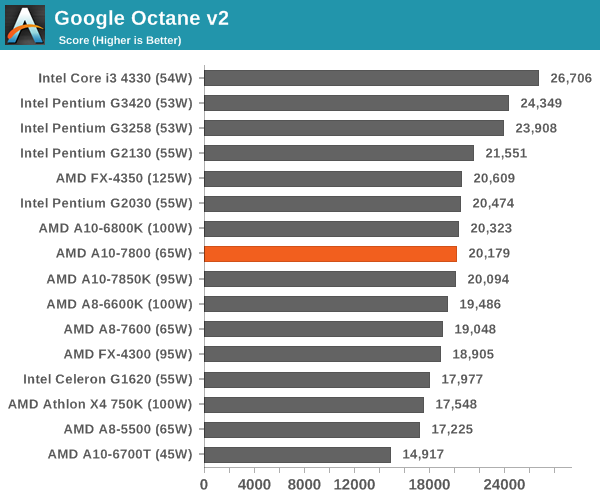










147 Comments
View All Comments
edlee - Thursday, July 31, 2014 - link
Nice review, but if I had a budget gaming machine, I would buy an inexpensive i5 with a better gpuRais93 - Thursday, July 31, 2014 - link
You do not understand what budget or inexpensive mean. An i5 complete platform costs few more than an a10 system, but for many people few dollars mattersnathanddrews - Thursday, July 31, 2014 - link
AMD A10-7850K - $170Decent FM2+ A88X mobo - $70 ($40-100)
Total base cost $240
Intel i5-4590S - $170
Decent 1150 H87 mobo - $70 ($30-400)
Total base cost $240
Add any identical dGPU, RAM, HDD/SSD, case, PSU, OS and the Intel system will dominate in every scenario for the same price.
http://www.anandtech.com/bench/product/1200?vs=119...
If no dGPU is allowed, then the AMD wins (in games and OCL/HSA only)... but would you seriously NEVER add a dGPU, even a year or two later? The moment that you do, you've essentially wasted your money on AMD. That's why the budget argument never makes much sense to me. You'll spend more over time buying ineffective budget rigs than you would if you spent more less often.
Flunk - Thursday, July 31, 2014 - link
If you're comparing Intel and AMD, as soon as you add the dGPU there is no reason to buy AMD. The CPU portion of the A10 is more comparable to an i3 than an i5 (and much worse single-thread perfomrance), you're paying for the iGPU more than anything.AMD's A-series processors make the most sense in cheap laptops that would never get a dGPU. Half-decent GPU and CPU performance make sense there. But if you're talking desktop, the second you add a GPU the value proposition flies out the window.
silverblue - Thursday, July 31, 2014 - link
There IS the option of Crossfire with an R7 but you can't rely on it to always boost performance. Still, it's a better proposition than in the past.Samus - Thursday, July 31, 2014 - link
AMD CPU power efficiency is also a 2.4:1 ratio to Intel.For example, AMD's FX-4350 is the most competitive CPU they have (in price) to an i3-4330. The i3 completely destroys it in most benchmarks, yet it uses 54w and the FX uses 125w.
That's anywhere from $8-$15/year in power usage depending on the workload. Ammortize that over 4-5 years and you may have just spent $50 more in electricity on the AMD CPU. This doesn't account for additional HVAC costs (air condition needs to run more to cool a room with AMD CPU's, increasing energy usage even more)
It's the same fact over and over. AMD is irrelevant because of their dinosaur manufacturing capabilities. They're always 2 generations behind Intel.
Gigaplex - Thursday, July 31, 2014 - link
Your electricity cost calculations assume 100% CPU load 100% of the time. Completely unrealistic.Samus - Friday, August 1, 2014 - link
Did you really not even read my comment? I clearly stated a range for a users workload. I didn't just give a universal figure.$8-$15 is the range from average workload to 100% workload. And that's assuming you're rate is $0.08/kwh. Parts of the country, such as Socal, are upward of $0.24/kwh. This means, at full load, AMD CPU's would cost about $1.00/day if run at full load 24/7, an extreme scenario, but the point was they use around 2.4x more power.
Unfortunately for AMD, that figure isn't a consistent scale in their favor; AMD CPU's idle at nearly quadruple the power of Intel's because they have no high-K dialetric to completely powergate unutilized sections of a core. All they can do is shut cores off, meaning one full core will always be on.
I was focusing on 100% workload simply because that's the least embarrassing presentation for AMD.
Audiolectric - Friday, August 1, 2014 - link
Well, different benchmarks taken by computerbase.de show that the 7800 actually idles at lower power consumption than the i3.From my own experience i can verifiy that, but only for mobile CPUs/APUs. I did own a msi gx60 and a gt60, and the gx60 was giving me about 30% more runtime from the battery.
and except for compiling the linux kernel, i couldnt tell any difference in everyday performance. (Of Courage in some games the a10 5750m was limiting performance when the i7 3632qm did not)
silverblue - Friday, August 1, 2014 - link
Well, one module would still be on, meaning two integer cores still being active. Still, there's nothing stopping a user from undervolting them and making significant power savings.